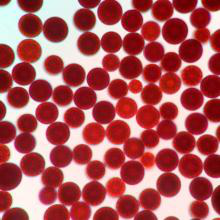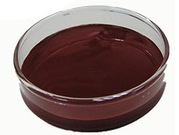Newly Arrival Astaxanthin Wholesale to Kuala Lumpur
Newly Arrival Astaxanthin Wholesale to Kuala Lumpur Detail:
[Latin Name] Haematococcus Pluvialis
[Plant Source] from China
[Specifications]1% 2% 3% 5%
[Appearance] Dark red Powder
[Particle size] 80 Mesh
[Loss on drying] ≤5.0%
[Heavy Metal] ≤10PPM
[Storage] Store in cool & dry area, keep away from the direct light and heat.
[Shelf life] 24 Months
[Package] Packed in paper-drums and two plastic-bags inside.
[Net weight] 25kgs/drum
Brief Introduction
Astaxanthin is a natural nutritional component, it can be found as a food supplement. The supplement is intended for human, animal, and aquaculture consumption.
Astaxanthin is a carotenoid. It belongs to a larger class of phytochemicals known as terpenes, which are built from five carbon precursors; isopentenyl diphosphate and dimethylallyl diphosphate . Astaxanthin is classified as a xanthophyll (originally derived from a word meaning “yellow leaves” since yellow plant leaf pigments were the first recognized of the xanthophyll family of carotenoids), but currently employed to describe carotenoid compounds that have oxygen-containing moities, hydroxyl or ketone , such as zeaxanthin and canthaxanthin. Indeed, astaxanthin is a metabolite of zeaxanthin and/or canthaxanthin, containing both hydroxyl and ketone functional groups. Like many carotenoids, astaxanthin is a colorful, lipid-soluble pigment. This colour is due to the extended chain of conjugated (alternating double and single) double bonds at the centre of the compound. This chain of conjugated double bonds is also responsible for the antioxidant function of astaxanthin (as well as other carotenoids) as it results in a region of decentralized electrons that can be donated to reduce a reactive oxidizing molecule.
Function:
1.Astaxanthin is a powerful antioxidant and may protect against oxidative damage to body tissues.
2.Astaxanthin can improve the immune response by increasing the number of antibody producing cells.
3.Astaxanthin is a potential candidate to treat neurodegenerative disease such as Alzhimer and Parkinson diease.
4.Astaxanthin dan reduce UVA-light damage to skin such as sunburn, inflammation, ageing and skin cancer.
Application
1.When applied in pharmaceutical field, astaxanthin powder has the good function of antineoplastic;
2.When applied in health food field, astaxanthin powder is used as food additives for pigment and health care;
3.When applied in cosmetic field, astaxanthin powder has the good function of antioxidant and anti-aging;
4.When applied in animal feeds field, astaxanthin powder is used as animal feed additive to impart coloration, including farm-raised salmon and egg yolks.
Product detail pictures:

Related Product Guide:
While in the past few years, our organization absorbed and digested innovative technologies both equally at home and abroad. Meanwhile, our organization staffs a group of experts devoted for the advancement of Newly Arrival Astaxanthin Wholesale to Kuala Lumpur , The product will supply to all over the world, such as: Danish, Ukraine, Finland, Our company insists on the principle of "Quality First, Sustainable Development", and takes "Honest Business, Mutual Benefits" as our developable goal. All members sincerely thank all old and new customers' support. We will keep working hard and offering you the highest-quality products and service.
Home Erectile Dysfunction Remedy Using Fruits
UCI Chem 128 Introduction to Chemical Biology (Winter 2013)
Lec 15. Introduction to Chemical Biology — Glycobiology & Polyketides — Part 1
View the complete course: https://ocw.uci.edu/courses/chem_128_introduction_to_chemical_biology.html
Instructor: Gregory Weiss, Ph.D.
License: Creative Commons BY-NC-SA
Terms of Use: https://ocw.uci.edu/info.
More courses at https://ocw.uci.edu
Description: Introduction to the basic principles of chemical biology: structures and reactivity; chemical mechanisms of enzyme catalysis; chemistry of signaling, biosynthesis, and metabolic pathways.
Introduction to Chemical Biology (Chem 128) is part of OpenChem: https://ocw.uci.edu/collections/open_chemistry.html
This video is part of a 18-lecture undergraduate-level course titled “Introduction to Chemical Biology” taught at UC Irvine by Professor Gregory Weiss.
Recorded March 5, 2013.
Index of Topics:
0:00:19 Carbohydrates
0:03:15 Glycosylated Proteins
0:07:25 Extending Oligosaccharides one Monomer at a Time
0:08:26 More Knee Join Oligosacchardies
0:10:25 Snot and Mucus: Anionic Polysaccharides
0:13:21 N-Linked Glycosides: Added as Complex Oligosaccharides
0:22:56 What is the Function of Glycosylation?
0:25:37 Cell Culture Production of Proteins
0:27:54 Glucoronidation Used to Designate Small Molecules for Excretion
0:29:49 Glucose Homeostasis
0:31:39 Non-Enzymatic Glycosylation
0:35:29 Sweetners: Tase Good for the Calories
0:41:00 Terpenes and Polyketides
0:45:09 Nature Prefers Thioesters for the Claisen
0:48:06 Rapid Exchange of Thioesters
0:49:28 Fatty Acid Synthesis by Polyketide
Required attribution: Weiss, Gregory Introduction to Chemical Biology 128 (UCI OpenCourseWare: University of California, Irvine), https://ocw.uci.edu/courses/chem_128_introduction_to_chemical_biology.html. [Access date]. License: Creative Commons Attribution-ShareAlike 3.0 United States License (https://creativecommons.org/licenses/by-sa/3.0/us/deed.en_US).
In China, we have many partners, this company is the most satisfying to us, reliable quality and good credit, it is worth appreciation.







